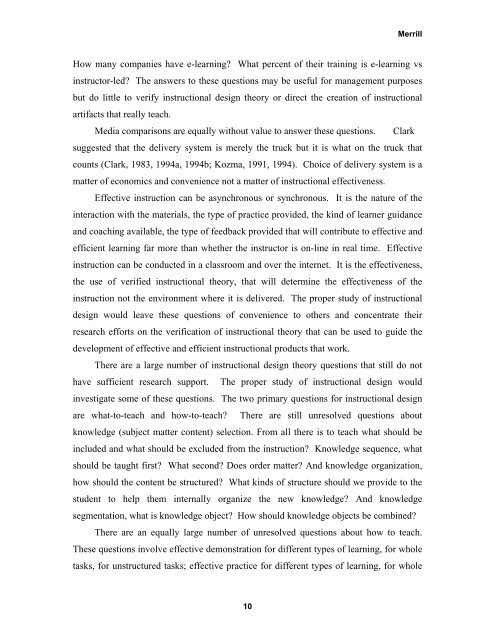The Proper Study of Instructional Design - David Merrill
The Proper Study of Instructional Design - David Merrill
The Proper Study of Instructional Design - David Merrill
Create successful ePaper yourself
Turn your PDF publications into a flip-book with our unique Google optimized e-Paper software.
<strong>Merrill</strong>How many companies have e-learning? What percent <strong>of</strong> their training is e-learning vsinstructor-led? <strong>The</strong> answers to these questions may be useful for management purposesbut do little to verify instructional design theory or direct the creation <strong>of</strong> instructionalartifacts that really teach.Media comparisons are equally without value to answer these questions. Clarksuggested that the delivery system is merely the truck but it is what on the truck thatcounts (Clark, 1983, 1994a, 1994b; Kozma, 1991, 1994). Choice <strong>of</strong> delivery system is amatter <strong>of</strong> economics and convenience not a matter <strong>of</strong> instructional effectiveness.Effective instruction can be asynchronous or synchronous. It is the nature <strong>of</strong> theinteraction with the materials, the type <strong>of</strong> practice provided, the kind <strong>of</strong> learner guidanceand coaching available, the type <strong>of</strong> feedback provided that will contribute to effective andefficient learning far more than whether the instructor is on-line in real time. Effectiveinstruction can be conducted in a classroom and over the internet. It is the effectiveness,the use <strong>of</strong> verified instructional theory, that will determine the effectiveness <strong>of</strong> theinstruction not the environment where it is delivered. <strong>The</strong> proper study <strong>of</strong> instructionaldesign would leave these questions <strong>of</strong> convenience to others and concentrate theirresearch efforts on the verification <strong>of</strong> instructional theory that can be used to guide thedevelopment <strong>of</strong> effective and efficient instructional products that work.<strong>The</strong>re are a large number <strong>of</strong> instructional design theory questions that still do nothave sufficient research support. <strong>The</strong> proper study <strong>of</strong> instructional design wouldinvestigate some <strong>of</strong> these questions. <strong>The</strong> two primary questions for instructional designare what-to-teach and how-to-teach? <strong>The</strong>re are still unresolved questions aboutknowledge (subject matter content) selection. From all there is to teach what should beincluded and what should be excluded from the instruction? Knowledge sequence, whatshould be taught first? What second? Does order matter? And knowledge organization,how should the content be structured? What kinds <strong>of</strong> structure should we provide to thestudent to help them internally organize the new knowledge? And knowledgesegmentation, what is knowledge object? How should knowledge objects be combined?<strong>The</strong>re are an equally large number <strong>of</strong> unresolved questions about how to teach.<strong>The</strong>se questions involve effective demonstration for different types <strong>of</strong> learning, for wholetasks, for unstructured tasks; effective practice for different types <strong>of</strong> learning, for whole10
















